Patience and Presence at the Roof of the World
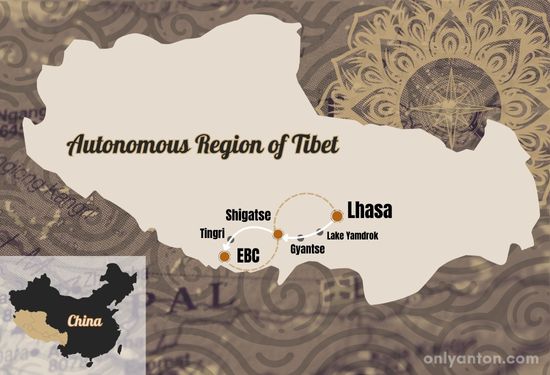
Introduction
In the summer of 2018, at the age of 52, I made the trek to Everest Base Camp in the heart of Tibet’s Himalayas. This journey tested my physical limits and expanded my philosophical horizons. It was more than just a trek towards the world’s highest peak. It was a transformative journey that pushed me to my limits and revealed the hidden treasures that lie off the beaten path, where the lines between the physical landscape and the cultural tapestry begin to blur.
As I navigated the challenging terrains and coped with the thinning air, I encountered more than just natural wonders. A humble Tibetan hut became a sanctuary, offering profound lessons in patience and the art of cultural exchange. These unexpected yet deeply enriching experiences transformed my understanding of what it means to travel. Each step along this high-altitude adventure told a story, not just of resilience and endurance but of revelation and introspection. The journey was a gateway to unique cultural and philosophical insights.
Join me on this extraordinary expedition to the Roof of the World, where every vista is a masterpiece of nature’s artistry, and every interaction is a whisper of timeless wisdom. From the bustling streets of Lhasa to the serene expanses of Yamdrok Lake, from the spiritual solitude of ancient monasteries to the communal simplicity of a Tibetan tent, this journey is a deep dive into the philosophy of travel and the transformative power of embracing the unknown. We’ll explore how letting go of expectations opens up new horizons, how serendipitous moments can offer the most significant lessons, and how the journey itself becomes the destination.
The Trip from Lhasa to Yamdrok Lake
Location
The leg from Lhasa to Yamdrok is one of the most visually stunning parts of the journey to Everest Base Camp. Lake Yamdrok, a jewel of the Tibetan plateau, lies around 114 kilometres (71 miles) southwest of Lhasa, and the drive takes 2 to 3 hours. As we ascended from Lhasa’s urban sprawl, the landscape transformed dramatically, revealing the rugged, untouched beauty of the Tibetan plateau. The serenity and grandeur of the surroundings were truly awe-inspiring.
Along the way, we made a brief stop at an ad hoc tourist site. A handful of local artisans were hawking their wares. A lone herdsman stood nearby with a yak in traditional livery, offering a chance for a photograph.
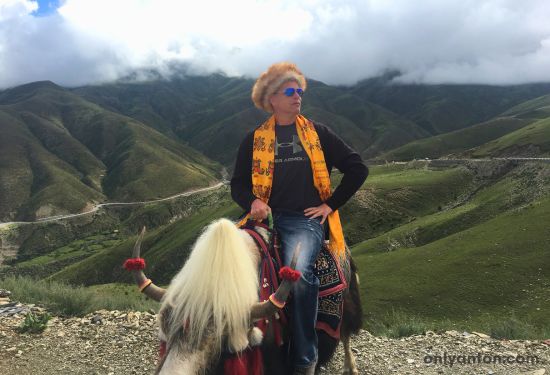
Experience and Interaction
The lake is a sacred body of water revered in Tibetan Buddhism as a talisman of the region’s spiritual essence. One of Tibet’s three holy lakes, Lake Yamdrok, sits at 4,441 meters (14,570 feet) and envelops visitors in its stark, serene beauty. With its sparkling turquoise waters, the lake is surrounded by a panorama of snow-dusted peaks, creating a surreal beauty that seems almost otherworldly.
The vibrant hues of the water and the tranquil surroundings serve as a spiritual pause. It is a reminder to travellers of the vastness and purity of nature. In addition, visitors can engage with local yak herders here and learn about their nomadic lifestyle, which has remained unchanged for centuries. This interaction isn’t just an exchange of smiles. It can be a profound connection to a life harmoniously woven with nature.
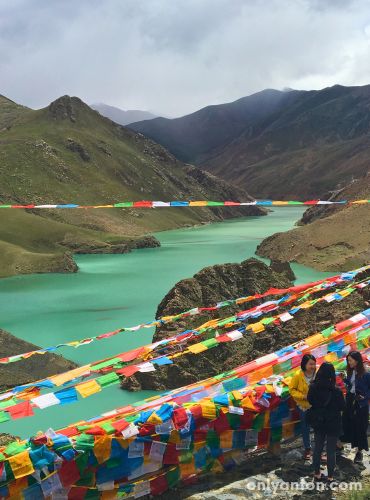
Practical Information
Even during the warmer months, travellers should prepare for the altitude and the cold. If you are not used to higher elevations, it is a good idea to bring medication to help you gradually adjust to the altitude and alleviate altitude sickness. Tour guides usually provide visitors with small emergency oxygen cans to ease the journey.
Stopping at Yamdrok provides a respite from the long drive to Everest and a chance to acclimate to the higher elevations. Since facilities here are minimal, visitors should bring essentials like water, snacks, and extra layers for warmth. Photography enthusiasts will find endless inspiration in the lake’s changing hues and picturesque surroundings. However, it’s essential to approach this sacred site with respect and mindfulness.
Environmental Considerations at Lake Yamdrok
As visitors to one of Tibet’s most sacred and visually stunning locations, we must tread lightly and respect the natural and cultural significance of Lake Yamdrok. Here are some eco-friendly practices and respectful behaviours to help preserve this pristine environment for future generations:
- Minimize Waste: Always carry back any trash you bring to the area, including plastics, food wrappers, and other disposables. Use reusable water bottles, bags, and other sustainable travel goods to reduce your environmental footprint.
- Respect Wildlife and Livestock: Maintain a safe and respectful distance from local wildlife and the yaks you might encounter. These animals are an integral part of the local ecosystem and culture. Feeding or disturbing them can negatively impact their health and the natural balance.
- Cultural Sensitivity: Lake Yamdrok is a natural wonder and a spiritual sanctuary. When visiting, speak softly, dress modestly, and avoid actions that could be considered disrespectful, such as loud music or inappropriate behaviour.
- Stay on Designated Paths: When exploring the lake, stick to marked trails and paths to prevent soil erosion and protect plant life. Straying from these paths can damage fragile vegetation and contribute to the degradation of the site.
- Support Local Communities: Engage with local artisans and herders by purchasing goods or using their services, such as yak rides, if offered respectfully and sustainably. Doing so will provide you with authentic experiences and help support the local economy.
- Educational Engagement: Learn about the area’s ecological and cultural importance. Understanding the significance of Lake Yamdrok can enhance your appreciation and promote a more mindful visit.
By following these guidelines, visitors can enjoy the profound beauty of Lake Yamdrok while ensuring they leave a minimal environmental impact and maintain respect for the sacred traditions of the region.
The Journey from Yamdrok to Shigatse Monastery
Location
After leaving the serene expanse of Yamdrok Lake, our path snaked further into the Tibetan highlands, guiding us toward Shigatse, the second-largest city in Tibet. Shigatse sits at 3,845 metres above sea level (12,600 feet). Here lies the venerable Tashilhunpo Monastery. Nestled against the stark slopes of Mount Niser, it is a cornerstone of Tibetan spirituality and history.
The southern route to Shigatse is the better and more scenic path. It passes some of the region’s most stunning attractions, like Lake Yamdrok and Gyantse. The route is 358 kilometres (222 miles) in length and takes all day to drive. We stopped halfway to visit Gyantse and the Pelkor Chode Monastery. Here, you will find the Kumbum, a stupa that stands 32 metres (105 feet) tall and is the only one of its kind in Tibet. Estimates place the Kumbum Stupa and the Pelkor Chode Monastery at an altitude of 4,552 metres (14,934 feet).
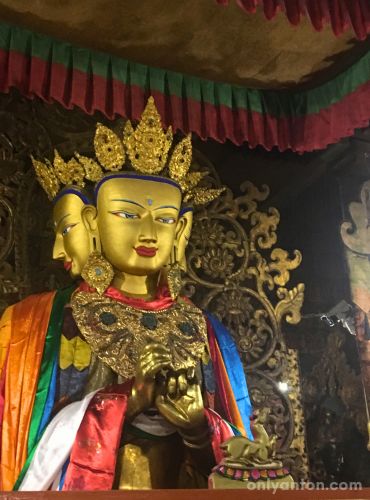
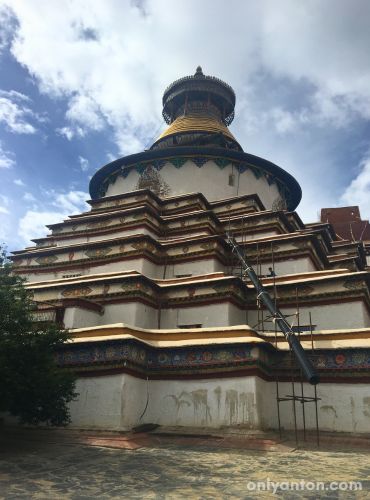
Historical Background and Spiritual Significance
We arrived at Shigatse in the late afternoon. Founded in 1447 CE by Gendun Drup, the First Dalai Lama, Tashilhunpo Monastery stands as a monumental “Heap of Glory.” For centuries, it has served as a religious sanctuary and the seat of the Panchen Lama, Tibetan Buddhism’s second-most revered figure. The monastery’s sprawling complex is a labyrinth of prayer halls, monks’ quarters, and sacred chapels. Each corner echoes with the deep tones of ceremonial horns and rhythmic chants.
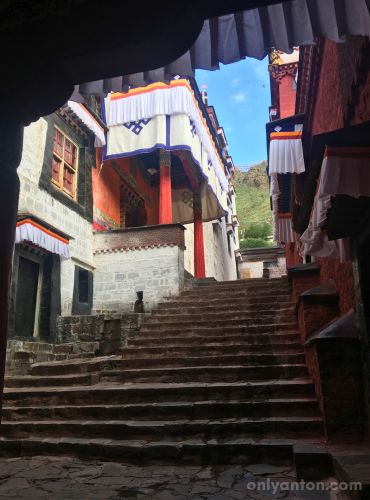
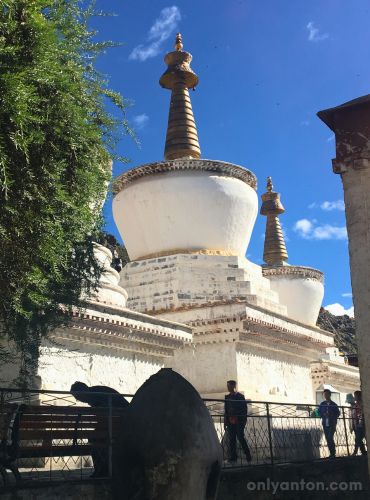
Architectural Marvels and Cultural Riches
I meandered through the monastery, appreciating the architecture, the traditional ornamentation, and the shadows cast within the courtyards outside the temple buildings. The interior of the monastery is relatively dark. Yak butter candles light gilded statues and walls lined with tomes and scrolls. A monk standing sentinel invites visitors to pay a small fee, allowing one to take photographs freely.
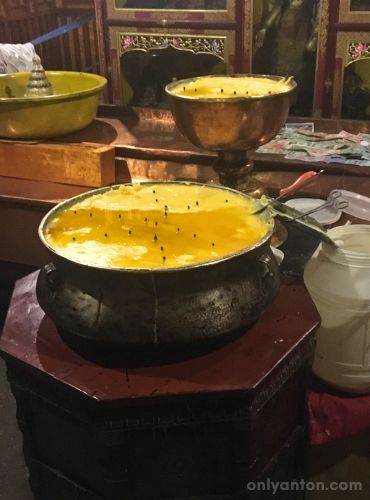
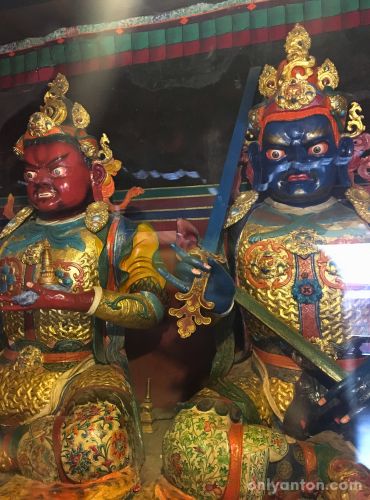
As I navigated the dark corridors, I was drawn to the heart of the monastery—the Maitreya Chapel. Here stands the towering Future Buddha, Maitreya. The statue stretches an impressive 26 meters (85 feet) toward the heavens, enveloped by an aura of devotion and artistry. The walls are adorned with intricate thangkas and ancient Buddhist scriptures. They narrate tales of faith that have withstood the test of time.
Engaging with Tradition
For those drawn to the spiritual path, the monastery’s courtyards during the Monlam Prayer Festival offer a vibrant tableau of devotion and community spirit. The Monlam Prayer Festival occurs from the 4th to the 11th day of the 1st Tibetan month (February 16-26, 2024). Pilgrims from across the globe gather, their faces lit by the soft glow of candlelight. Their prayers ascend with the incense smoke, weaving a tapestry of collective aspiration.
Practical Advice for Travelers
Visiting Tashilhunpo is a journey through time and spirit. Travellers are encouraged to partake respectfully in the daily rituals, perhaps even attending a prayer session. However, it’s essential to approach it with the sensitivity required for such a sacred site. Dress modestly, speak softly, and move with reverence. Be prepared for the altitude with adequate hydration. Remember that the spiritual journey here is as significant as the physical one.
Tashilhunpo Monastery offers a window into the soul of Tibetan Buddhism. Yet, it also invites us to reflect on our own spiritual bearings. In its shadow, we find a testament to religious devotion and a mirror reflecting our innermost quests.
The Trek to Everest Base Camp and Rongbuk Monastery
Introduction
Leaving the spiritual enclave of Shigatse behind, our route veered towards the rugged north face of Mount Everest. This leg of our journey was marked by a palpable shift in landscape and atmosphere as we approached the world’s highest peak. The road to Everest Base Camp is a journey of extremes—extreme beauty, extreme altitude, and extreme conditions—converging in the shadow of the earth’s highest point.
Location
Everest Base Camp (EBC) lies in the southwest of Tibet, near the border with Nepal. The drive from Shigatse to Everest Base Camp passes first through Tingri. On average, it takes about three hours to journey from Shigatse to Tingri without stopping. Our group took longer, stopping to take photos and get lunch.
The final stretch from Tingri to EBC is around 100 kilometres (62 miles) and takes about two hours to drive. The route crosses the central mountain passes into the Qomolangma National Park. The Gawu La Pass, at an altitude of 5,198 metres (17,053 feet), usually gives a panoramic view of the Himalayas, including Mount Everest and several of the other highest mountains in the world.
The Ascent
As we ascended the Tibetan Plateau, the air thinned. The landscape unfolded in vast expanses of rugged terrain punctuated by the vibrant colours of prayer flags fluttering against stark white peaks. Each stop along the way, whether for a quick refreshment or a necessary checkpoint attended by stern-faced soldiers, reminded us of the complexities of travelling in such a remote and politically sensitive area. The presence of heavy security underscored the region’s geopolitical tensions and added a layer of solemnity to our high-altitude pilgrimage.
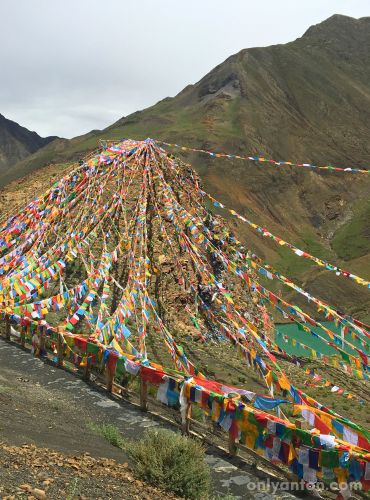
Everest Base Camp
Everest Base Camp sits at an elevation of 5,150 meters (16,900 feet). Reaching this place was a triumph and a testament to human endurance. The camp is a transient community of adventurers, each drawn here by the allure of Everest’s towering majesty. Facilities are minimal, consisting primarily of temporary structures and tents that do little to shield against the biting cold. Here, the reality of high-altitude trekking became apparent. The air is thin, the winds are harsh. The bone-chilling cold seeps through every layer. In the middle of the stony valley is a marker displaying Mount Everest’s altitude (8,844.43 metres). The latest estimates from 2020 now put the altitude of Mount Everest at 8,848.86 metres (29,031.69 feet).
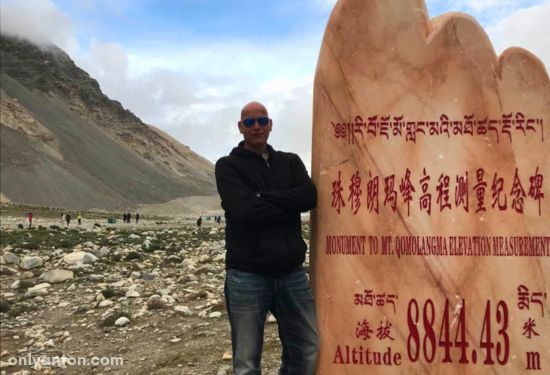
Rongbuk Monastery: A Sanctuary in the Clouds
Just 8 kilometres from the base camp, Rongbuk (Rongpu) Monastery is one of the highest monasteries in the world. Some claim it is, in fact, the highest. Others report that Rongbuk is only the fourth highest monastery, after Drirapuk Monastery (5,210 m), Gyangdrak Monastery (5,075 m), and Selung Temple (5,020 m).
The monastery’s simple structure belies its profound spiritual depth. Established in 1902, Rongbuk is a place of worship and a vantage point offering unparalleled views of Everest. It serves as a spiritual sanctuary for those seeking solace and strength before facing the mountain’s formidable presence.
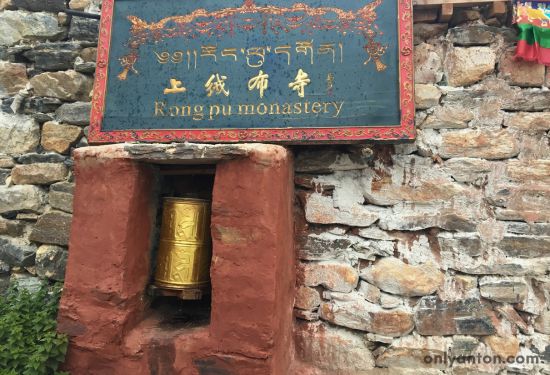
Spiritual and Scenic Significance
The monastery is integral to the Everest experience, blending the awe-inspiring natural beauty with deep cultural and spiritual significance. When you can see Everest from Rongbuk, it is said to be transformative, revealing not just a mountain but a symbol of the sublime—a peak that challenges adventurers physically and spiritually.
Personal Reflection
As the day ended, we retreated from the base camp to the monastery. The elusive peak of Everest hid behind a veil of clouds. It was a reminder that some beauties remain aloof, visible only to those who wait patiently or return with hopeful hearts. It was an opportunity to reflect on the absurdity of finding myself here. If people had told me a year earlier that I would be standing at this spot, I would have said they were crazy.
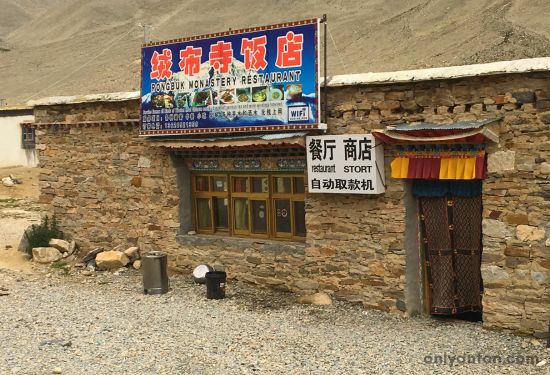
The monastery offers travellers accommodations in simple concrete block barracks. A modest restaurant serves simple fare. The toilet facilities may surprise visitors: a vast gaping hole in the concrete floor. Our group slept together in one room on simple cots, wearing our clothes to stay warm. Sleep was elusive and fitful in the cold and thin atmosphere. Some people needed to use the emergency oxygen cans. I lent my air supply to those who needed it more than I did. Our journey was not just toward a place on a map. It was an exploration into the extremes of nature and human endeavour.
A Transformative Experience at the Roof of the World
Introduction
On our final morning at Everest Base Camp, we prepared to leave for the long trek back to Lhasa. The distance from Shigatse to Lhasa along the northern route, using the G318 Friendship Highway, is around 268 kilometres (166 miles), and it is a direct route with no stops.
Low, grey clouds hung over the valley like an undulating ceiling. Cloaked in the foggy embrace of the Himalayas, I found myself at a crossroads of expectation and reality. My travel companions ventured out into the mist, hoping for a final glimpse of Everest’s elusive summit. I chose a different path that led me to warmth and wisdom inside a modest Tibetan tent.
The Setting
The weather was cool, with a soft drizzle that echoed the sombre mood of our failed attempts to view Mount Everest. Despite the disappointment, an unexpected invitation from our Tibetan guide took me on a journey inward. I stooped and entered the warmth of a nearby tent. Dried yak dung fuelled a central stove, exuding a distinctive scent. A tableau of Tibetan life greeted me.
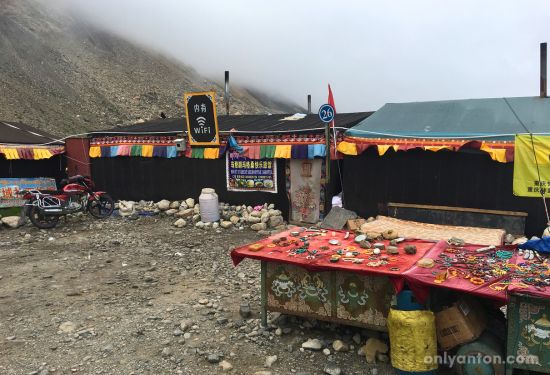
The Encounter
As I settled onto the rug-covered seats, a local woman behind the stove offered me a steaming cup of yak butter tea. She smiled and motioned for me to sit at the table. Another local Tibetan man motioned to me, wordlessly asking me if I would care for some food. I nodded in assent. He took my cup of buttered tea and poured a little into a bowl containing roasted buckwheat flour. He kneaded the mixture of flour and tea into a smooth dough and offered it to me while returning my tea.
My Tibetan guide explained that the man had prepared tsampa—a traditional Tibetan breakfast of roasted buckwheat flour mixed with butter tea. This simple meal shared in silence yet full of meaning, became a sacrament of the moment. Here I was, a tall, bald, Dutch Canadian man, sitting in a humble hut surrounded by locals, eating a traditional Tibetan breakfast and being heated by a traditional yak dung fire. Meanwhile, my travel companions were standing in a cold, wet, foggy field of stones, futilely trying to capture a picture of the iconic Mount Everest.
I can’t fault my fellow travellers for wanting to see the fabled peak. Was it my hope, my aspiration, to see Mount Everest? Definitely. Was it my preference to see Mount Everest? Absolutely! Did I expect to see Mount Everest? No. The tour website forewarns travellers that Mount Everest is not always visible during the summer.
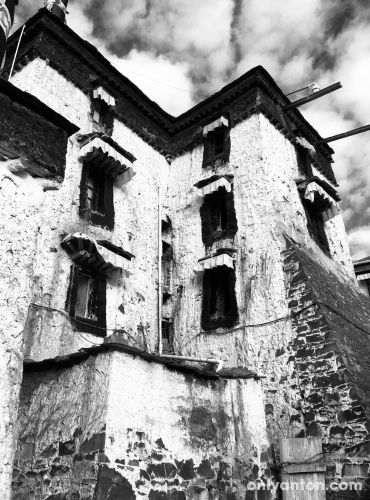
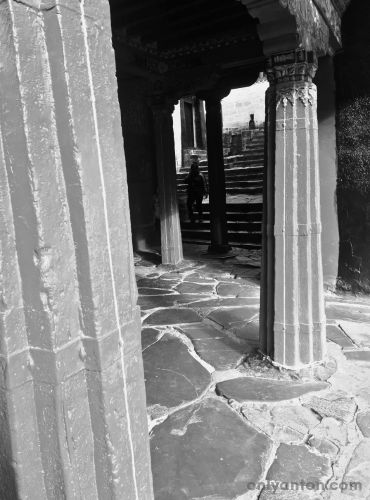
Philosophical Reflections
In the quiet simplicity of the tent, a truth dawned upon me—one that resonates deeply with the principles of mindful and slow travel. It was an illumination that hit me in real time, not retrospectively. I appreciated it at that moment, and I was grateful for it. Here, in the heart of the Himalayas, I was living the essence of authentic travel:
1. Presence Over Expectation:
Often, we travel with fixed ideas of what we must see and experience. Understandably, my travel companions hoped to catch sight of Everest’s peak. Yet true discovery lies in letting go of these expectations and embracing what is present. As the Buddha might say, “Serenity comes when you trade expectations for acceptance.”
2. Openness to Serendipity:
By choosing not to chase the elusive sight of Everest, I opened myself to the possibility of genuine connection. Buddhist teachings remind us that attachment leads to suffering. In travel, as in life, detachment (or non-attachment) from desired outcomes allows us to experience the fullness of the unexpected. It is vital to move with intention, to have a goal and take steps towards it. However, one should not be attached to any particular outcome. That is outside of your control. Hope is essential in life, but hold it loosely while still being open to what is in front of you.
3. Gratitude for the Moment:
The warm tsampa, the shared smiles, the heat of the fire—each was a gift of the moment, inviting gratitude. In this unexpected breakfast lay a lesson: to be grateful for what is rather than resentful for what isn’t. I may have lost the chance to see Mount Everest, but I had found a companion: someone with whom you eat bread.
4. The Beauty of Now:
The most memorable experiences often arise not from planned encounters but from the unplanned moments that find us when we are truly present. This is the heart of slow travel—savouring each moment as it comes, without haste and without the overshadowing of what might have been.
As I rejoined my companions, their spirits dampened by unmet expectations, I carried a different kind of souvenir in the truest sense of the word: a memory. I may not have a photograph of Mount Everest. Yet, I have an unforgettable memory and a profound appreciation for the unexpected lessons of life and travel. This experience at the roof of the world was a vivid reminder that sometimes, the best way to climb a mountain is not to scale its peaks but to traverse its base, open to the wisdom it offers.
Conclusion
During the long drive back to Lhasa from the majestic yet elusive Everest Base Camp, I carried with me memories of breathtaking landscapes and invaluable insights into the essence of travel and life itself. This journey was more than a physical trek. It was a profound exploration of the boundaries between the familiar and the extraordinary, between aspirations and reality.
In the quiet simplicity of a Tibetan tent, over a humble breakfast of tsampa, I discovered that the true treasures of travel aren’t always the ones we set out to find. They are often hidden in plain sight, waiting in the spaces between our planned destinations. Such treasures are revealed only when we pause to look and see. This journey taught me that exploration is not just about pursuing distant horizons. It’s about embracing the moment, welcoming the unexpected, and finding joy in the journey itself.
To my fellow travellers and curious souls of the “Only Anton” community: may you always travel with an open heart and a curious mind. May you find as much beauty in the unexpected detours as you do in reaching your destination. And may you discover, as I did on the Roof of the World, that sometimes the most profound journeys are the ones that lead you inward.
What About You?
At Only Anton, your stories and reflections are as important as the ones I share. Have you ever found patience to be a guiding force in your travels? Whether it’s waiting for the perfect moment to capture a photo or embracing unexpected detours, patience can unravel the most enriching experiences. I’d love to hear about your encounters with different cultures and the moments that tested your composure. What lessons did you learn? Feel free to share your tales in the comments below. And if you’re hungry for more musings on philosophy and travel, venture into the “Think” category, where I delve into the intersections of thought and exploration.
Further Reading
Explore the depths of Tibetan culture and prepare for your own high-altitude adventure with these carefully selected books, blogs, and online resources. Whether you’re planning a trek to Everest Base Camp or simply wish to learn more about the region from the comfort of your home, these resources offer invaluable insights and inspiration.
If you’re interested in reading more of my adventures in Tibet, check out my post about
For more about meaningful travel, read my other posts:
Books
- Seven Years in Tibet (illustrated edition, 2009) by Heinrich Harrer: The adventure classic by one of the first Europeans to enter Tibet after the Chinese Communist takeover. Watch the 1997 film by Jean-Jacques Annaud and starring Brad Pitt, read it online, or get it at your local library. You can purchase your own copy here.
- Tibet: The Bradt Travel Guide (4th edition, 2018) by Michael Buckley: A guide to travel in Tibet, including cultural and historic information, safety advice, maps, and the best routes to take. Look for it online or at a library near you. Or pick it up here.
- Lonely Planet Tibet (10th edition, 2019), by Stephen Lioy, Megan Eaves, and Bradley Mayhew: Up-to-date advice on what to see and do in Tibet. The book contains colour maps, highlights and itineraries, insider tips, and essential information. Get your copy from Amazon here.
Online Resources:
- Tibet Vista (tibettravel.org): Many tour companies can facilitate your adventure in Tibet. This is the tour group I used while I was still living and teaching in China. My personal experience with them was great and the local Tibetan guide was amazing. Check their website here for more information about travel to Tibet and to explore the many travel packages they offer.
- Everest Base Camp Trek Guide: An extensive guide detailing routes, preparation tips, and what to expect on your journey. Explore the guide here.
- Himalayan Wonders Blog: Offers insights, updates, and personal stories from trekkers who have experienced the challenges and beauties of Himalayan treks, including Everest Base Camp. Visit the blog here.




